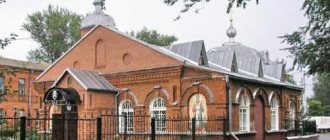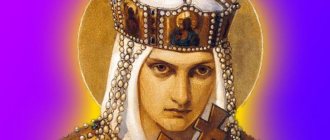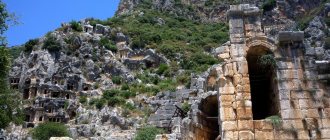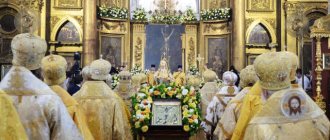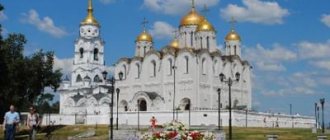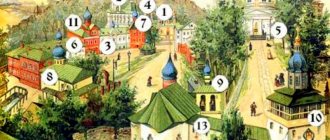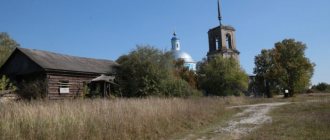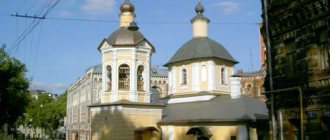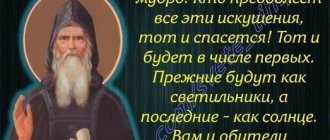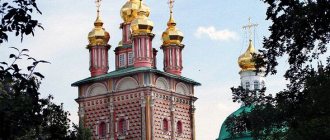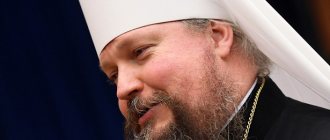| Ascension Cathedral in Kasimov, photo from the site kasimov.biz |
Kasimov and Sasovo Diocese of
the Ryazan Metropolis of the Russian Orthodox Church
- Diocesan administration: Russia, 391300, Ryazan region, Kasimov, Karl Marx street, 11
- Tel.: (49131) 4-46-85 (submission of petitions and all questions related to the office and document flow); (49131) 4-46-87 (fax)
- Official site:
- Canonical territory: Ermishinsky, Kadomsky, Kasimovsky, Klepikovsky, Pitelinsky, Sasovsky, Chuchkovsky, Shilovsky districts of the Ryazan region.
- Cathedral: Ascension in Kasimov
- On the map: Yandex.Map, Google map
In the 1920s, there was the Kasimov Vicariate of the renovationist Ryazan diocese.
The Orthodox independent Kasimov diocese was established on October 5, 2011, having been separated from the Ryazan diocese within the boundaries of the Ermishinsky, Kadomsky, Kasimovsky, Klepikovsky, Pitelinsky, Sasovsky, Chuchkovsky and Shilovsky districts of the Ryazan region. On October 6 of the same year, it was included in the newly formed Ryazan Metropolis.
Statistics
- December 31, 2012 - 109 parishes. Full-time clergy - 103, of which priests - 95, deacons - 8. Supernumerary priests - 2. Religious priests - 8, deacons - 1. Monk - 1. In the Merciful Mother of God convent in the village of Kadom, nuns - 4; nuns - 1. [1]
Brief description of Kasimov
Kasimov is a small Russian city in the Ryazan region . Kasimov is the administrative center of the Kasimovsky district, but is not part of it. The area of Kasimov is 31.6 km2, and the population is about 31 thousand people. The main nationalities in the city are Russians and Tatars, the main confessions are Orthodox and Muslims (Sunnis).
The city of Kasimov is located 170 km northeast of Ryazan (on the left bank of the Oka River
A little history of the city
Historians believe that Kasimov was founded in the 12th century. True, then it was called “Gorodets Meshchersky”. Yuri Dolgoruky created a fortress of the Vladimir-Suzdal principality on this site, but in the 14th century the fortress was burned, and a new city was built not far from the fire (New Lower City - until 1471). In the 15th century, there was a fierce struggle between the princes for the Moscow throne; one of the contenders was Prince Vasily the Dark. He was supported by the Tatar princes Kasim and Yakub (they were forced to come to Moscow peacefully - they were fleeing from their brother Makhmutek). Vasily gave Kasim the Lower City for his help. The Tatar Khan formed the Kasimov Khanate. Until the end of the 17th century, it also included Shatsky, Elatomsky and Temnikovsky districts.
When the last ruler of the Khanate, Fatima Sultan, died, the entire Khanate passed to the palace volosts, but the mosques and mausoleums of the Tatar princes were not destroyed. They also decided to keep the name of the city, and in 1773 Kasimov became the center of Kasimovsky district. In 1937, the Ryazan region was formed, and the Kasimovsky district became part of it. Kasimov's last politically and economically important event was the opening of a non-ferrous metals plant. In the 90s of the 20th century, gang wars were fought because of this. Now Kasimov has stable manufacturing enterprises, an active cultural life, and tourists visit this provincial town for sightseeing - evidence of a rich history.
How to get to Kasimov
Here are several ways to get to Kasimov:
- By plane with a transfer in Moscow (from other countries or distant cities).
- By train with a change in Moscow or Shilov (you can get from Shilov by train).
- By bus from Moscow (Shchelkovsky bus station).
- By cruise ship from Moscow or Nizhny Novgorod (only during the navigation season).
- By personal car or taxi (via Lyubertsy, Voskresensk, Murom, Ryazan or Shatsk).
The most convenient way to get to Kasimov is by car from Murom, Shatsk or Ryazan (from Moscow it is convenient to go through Yegoryevsk - this road was previously called the Kasimovsky tract)
No. 26 (731) / July 8 '13
Church life
Bishop of Kasimov and Sasov Dionysius
Date of birth: October 1, 1975 Date of consecration: November 27, 2011 Date of tonsure: August 28, 2000
- Born in Ryazan into a family of employees.
- In 1992 he graduated from secondary school-gymnasium No. 5 in Ryazan. In 1997 he graduated from the Russian State Pedagogical University with a degree in History and English Teacher.
- On September 1, 1998, he entered the St. John the Theological Monastery of the Ryazan Diocese, where on November 1 of the same year, with the blessing of Archbishop Simon of Ryazan and Kasimov, Bishop Joseph of Shatsky, vicar of the Ryazan Diocese, made him a subdeacon. Since January 1999 – senior subdeacon and cell attendant of Bishop Joseph of Shatsk.
- In 1998–2001 studied at the correspondence department of the Ryazan Theological School.
- On March 27, 1999, he was ordained a deacon at the St. John the Theologian Monastery and appointed a monk of the monastery. On March 23, 2000, he was enrolled in the brethren of the St. John the Theologian Monastery.
- On August 28, 2000, he was tonsured into the mantle with the name Dionysius in honor of the Hieromartyr Dionysius the Areopagite, Bishop of Athens.
- In 2002–2009 studied at the correspondence department of the Moscow Theological Academy.
- Since April 2004 - personal secretary of the rector of the St. John the Theological Monastery, Bishop Joseph of Shatsk. Since March 2005 – acting Dean of the St. John the Theologian Monastery, since January 2006 - Dean.
- On November 4, 2006, Archbishop Pavel of Ryazan and Kasimov ordained him a hieromonk.
- In 2007, he was awarded the right to wear a loincloth and the right to wear a pectoral cross.
- October 5, 2007 appointed acting Abbot of the St. John the Theologian Monastery. By the decision of the Holy Synod of December 27, 2007, he was appointed abbot of the St. John the Theologian Monastery.
- On May 21, 2009 he was elevated to the rank of abbot.
- On March 2, 2011, he was appointed rector of the St. John the Theologian Monastery. On May 4, 2011 he was awarded the right to carry a club.
- On May 17, 2011, he was appointed chairman of the Board of Trustees of the Ryazan diocese. On May 24, 2011, he was appointed secretary of the ecclesiastical court of the Ryazan diocese.
- Since 2004 – senior lecturer in the department of theology, faculty of Russian philology and national culture, Ryazan State University. S.A. Yesenina. Since 2006, he has been teaching a course on the history of the Ancient Church at the Ryazan Theological Seminary.
- By the decision of the Holy Synod of October 5–6, 2011 (magazine No. 135), he was elected Bishop of Kasimov and Sasov.
- On October 9, 2011 he was elevated to the rank of archimandrite.
- On November 27, 2011, during the Divine Liturgy in the Cathedral of the Nativity of the Blessed Virgin Mary, His Holiness Patriarch Kirill led the consecration of Archimandrite Dionysius as Bishop of Kasimov and Sasov.
Brief information
Date created: October 5, 2011
It is part of the Ryazan Metropolitanate.
Formed by the decision of the Holy Synod of October 5-6, 2011 (magazine No. 104) by separating from the Ryazan diocese. The Synod decided to have the titles of Kasimovsky and Sasovsky for the ruling Bishop. The Synod also decided (magazine No. 132) to include the Kasimov diocese into the Ryazan Metropolis.
Unites parishes within the administrative boundaries of Ermishinsky, Kadomsky, Kasimovsky, Klepikovsky, Pitelinsky, Sasovsky, Chuchkovsky and Shilovsky districts of the Ryazan region. The number of parishes in the diocese is 109.
Address: 391308, Kasimov, st. 50 years of the USSR, 29. Telephone: (49131) 4-46-85. Fax: (49131) 4-46-87. Website: https://kaseparh.ru E-mail:
Monasteries:
- The Merciful Mother of God Women's; 391670, Ryazan region, r.p. Kadom, trans. Oktyabrsky, 1; tel. (49139) 5-13-49; e-mail
- Holy Cross Poluninskaya monastic community (Bishops' Compound); 391515, Ryazan region, Shilovsky district, village. Red Hill, Holy Cross Church; tel. +7906 647-31-13; e-mail
Diocesan media:
- official website of the Kasimov diocese;
- deanery websites.
Educational establishments:
- Non-state educational institution "Orthodox school of Kasimov" 391308, Ryazan region, Kasimov, st. 50 years of the USSR, 29; tel. (49131) 4-37-58; e-mail
Merciful Mother of God Convent
Founded in 1793 in the city of Kadom (by the way, the first mention of Kadom in the Nikon Chronicle dates back to 1209) of the Temnikovsky district of the Tambov province (currently Kadom is the regional center of the Ryazan region) by E. Rozhnova, the daughter of a merchant.
In 1797, the Kadoma almshouse was established at the Demetrius Church, in 1849 the almshouse was transformed into a community, and in 1868 into a convent, which operated according to the charter of the Sarov Hermitage, under the spiritual guidance of its elders.
The main church of the monastery was built in 1857, the second church - in 1860-1865, the third - in 1896-1911. All churches are stone. There are 15 residential buildings, outbuildings, and a courtyard in the city. The monastery was governed by the abbess.
By 1917, 372 people lived here, incl. 111 nuns. The monastery was maintained with funds from the rental of land (763 dessiatines), meadows and gardens, the sale of honey from the apiary and interest on a capital of 114 thousand rubles.
In 1918, the Kadomsky Merciful Mother of God Convent was closed. The complex of monastery buildings is well preserved. Re-opened in April 1997.
In other rooms:
Popular attractions of Kasimov
Popular attractions of the city include cultural entertainment, architectural, natural and historical monuments.
City architecture
The architectural sights of Kasimov are represented by monuments of federal significance built in the 15th–16th centuries and later.
Annunciation Church
The Annunciation Church of Kasimov was built in 1740 (during the years of service of priest Fyodor Ioannov). In the history of the temple there were fires (the first in 1775) and other mysterious events. In 1784, the temple was reconstructed, so a second chapel appeared, but in 1792 they wanted to dismantle the church completely, but the parishioners opposed it. The diocesan authorities had to leave the Annunciation Church, but at that moment the construction of a new church had already begun (now there is a chapel there). Another reconstruction took place in the 19th century. After the revolution, the temple was closed, so the building fell into disrepair. With the opening, the church had to be reconstructed again, but now it is operational.
One mysterious story is connected with the appearance in the city of the Kazan Icon of the Mother of God (painted in 1727). When the icon appeared in the Church of the Annunciation, local parishioners immediately felt its divine power. There have been many fires in Kasimov, but local residents believe that it was the icon that saved people during disasters. After the revolution, the relic was taken to the local history museum, and from there the miraculous icon disappeared.
Practical information:
- address: Cathedral Square, 13 "A";
- official website of the deanery: https://kasblag.ru;
- the schedule of services is on the deanery website;
- the entrance is free.
The full name of the Annunciation Church is the temple in honor of the Annunciation of the Blessed Virgin Mary
Assumption Church
The Assumption Church of Kasimov was built in 1775. Previously, she was considered the most beautiful and well-groomed in the city, they wrote about her: “that before there were Three Saints.” Like most ancient churches, this temple was rebuilt and repaired many times. When the Assumption Church was located in an old wooden building, next to it there was another temple - in the name of the Cathedral of the Blessed Virgin Mary (this was a warm church that worked in winter). After fires in the 18th century, it was decided to build a stone temple. The whole city collected money for the construction of the church, and merchants also helped. In 1810, a hurricane damaged most of the stone church: the roof was blown off and the bells were broken. By 1833, the reconstruction of the church was completed.
At the beginning of the 20th century, the architect Tsehansky came to Kasimov. He took part in another major reconstruction of the temple. The newly opened temple had 5 thrones at once: the Assumption, Bogolyubsky, Vozdvizhensky, Life-Giving and in the name of the saints. In 1933, the city council issued a sad verdict that the temple was in disrepair, and a year later the most beautiful church in the city was closed. A city library was made in the main building of the temple, and after another 3 years storage facilities were equipped here. The only thing the parishioners achieved was that the church building was allowed not to be dismantled.
Practical information:
- address: Sobornaya Square, 1;
- official website: https://kasblag.uspenskij-khram;
- Opening hours: the temple is inactive, it can only be viewed from the outside;
- There is no need to pay to see the attraction.
The temple in honor of the Dormition of the Blessed Virgin Mary belongs to the Kasimov diocese of the Russian Orthodox Church
House of Nastavins
The Nastavin House is an architectural monument of federal significance, built in 1813. The building was built by Princess Elizaveta Ivanovna Putyatina (she was the wife of the local mayor). A large garden was laid out around the house, which continued to the Nikolsky ravine. This is the first house built in Kasimov in the unusual Corinthian style (subsequent buildings were built following the example of this house). In 1830, the mansion passed to the merchant Polezhaev, he initiated reconstruction (architect - I. S. Gagin). In 1850, the building had a new owner - merchant Barkov. The last owners of the mansion were the Nastavins (since 1860), hence the name of the house.
After the revolution, various government organizations were located in the premises of the mansion. Now some apartments are empty, and some are occupied by private owners. Of course, not a trace remains of the old interior decoration, but the façade of the building looks the same as before.
Practical information:
- the mansion is located on Cathedral Square;
- exact coordinates: 54°56'17″N 41°23'24″E;
- You can inspect the house at any time and for free.
The Nastavins’ house was chosen to play the role of the mayor’s house during the filming of the film “Incognito from St. Petersburg” based on N. V. Gogol’s play “The Inspector General”
Shopping arcades
Shopping arcades in Kasimov were built in the first half of the 19th century. Funds for the construction of the market were collected by representatives of the merchant class. It was planned to build four Gostiny Dvor buildings, but only 3 of them were built. The author of the project was I. S. Gagin (at that time he was the most popular architect in the city). The architectural style of the buildings is Empire style. Now the shopping arcades are not functioning, but they are a tourist point of any excursion.
Practical information:
- address: Cathedral Square, 3 “B”;
- exact coordinates: 54°56'10″N 41°23'26″E;
- You can visit the shopping arcades at any time and for free.
The buildings are one-story, surrounded by galleries with paired columns, which created a visual feeling of lightness and, at the same time, monumentality
Ascension Cathedral
The Ascension Cathedral was built in the 16th-17th centuries. At first the temple building was wooden, but after two fires and restorations a new stone church was built. The five-domed church was built with the money of governor Vasily Khovrin, and in 1754 the temple was completed and consecrated by Metropolitan Sechenov. After 24 years, the bell tower was also replaced (this was financed by V. A. Gubarev). Over the course of 100 years, the cathedral was reconstructed several times, a new iconostasis, a second chapel, etc. appeared. In the 19th century, another temple was built, since the old one was already outdated and dilapidated by that time.
At the beginning of the 20th century, the cathedral was closed, and some of the relics were stolen. In 1936, a flying club was created here, and the bell tower of the temple was used as a parachute tower. After the Great Patriotic War, the bell tower was completely dismantled. The temple was returned to the Russian Orthodox Church in 1998. A few years later, funds were raised for restoration and the church was restored.
Practical information:
- the church is located in the center of Cathedral Square;
- official website: https://kasblag.kafedralnyj-sobor;
- the schedule of services is on the official website of the deanery;
- Free admission.
In 1571, Kasimov is described in the scribal books of Peter Voeikov as a wooden city, which mentions the wooden cathedral church of the Ascension of Christ with a chapel in honor of the Beheading of the venerable head of John the Baptist
Khan Mosque
The Khan Mosque (Qasim Khan Mosque) was built in the 18th century, and its minaret - in the 15th century. The two-story building is a monument of Tatar religious architecture. Architectural style - classicism. In 1702, the main part of the mosque was destroyed by order of Peter the Great, but the minaret remained. In the 18th century, Catherine II issued a decree according to which Bektemir Seid, his son and Ibrahim Murza were allowed to restore the temple. True, the new mosque was smaller in size than the previous one, and instead of two floors, only one was built. At the beginning of the 19th century, Salih Seid built the second floor of the mosque.
After the revolution, the mosque building began to be used as a museum. But in 2013, the Arbitration Court of the Ryazan Region decided that the mosque should be returned to Muslims. Now the Khan Mosque is in the possession of the Spiritual Administration of Muslims of the European Part of Russia. The Museum of Ethnography of the Kasimov Tatars is located here, and there is an observation deck in the minaret.
The opinions of historians differ on the issue of construction of the building. Local residents believe that the Muslim temple was built by Khan Qasim. But there are scientists who believe that the initiator of the construction was Shah Ali Khan (16th century).
Practical information:
- address: Pobeda Square, 8;
- exact coordinates: 54°56′00″N 41°23′49″E;
- Opening hours: daily, except Mondays (from 9.30 to 17.00);
- entrance fee: 100 rubles.
The Khan's mosque in Kasimov is very different from the original version of the mosque built by Kasimov
Tekiye of Shah Ali Khan and Afghan Mohammed Sultan
Tekie in Kasimov are the tombs of two Tatar khans. Essentially these are mausoleums, in one of which Shah Ali is buried, and in the other - Afghan Mohammed. They were built between the 15th and 17th centuries. The tomb of Shah Ali Khan is made of white stone, and that of Afghan Mohammed is made of red brick. The mausoleums are impressive in size: their height reaches 5 meters, and their length reaches 14 meters. Both mausoleums are part of the structure of the historical and architectural museum of the Ryazan region.
Among my friends there are many Misher Tatars. One of them is seriously interested in national culture. He told me an interesting story. When Shah Ali died, Sain-Bulat became the prince of Kasimov. Over time, he changed his faith, being baptized and taking the Orthodox name pleasing to God Simeon. Ivan IV made him prince of Rus' and the Tver region. In the library archives there are still copies of chronicles where the prince is called Simeon Bekbulatovich. True, later Tsar Simeon deprived him of the honorary title, but gave him Tver and Torzhok. Among the Tatars (and some Russians) the surname Bekbulatov is found; it is believed that it indicates a distant relationship with the Tatar prince.
Practical information:
- address of Tekie Shah-Ali Khan: Victory Square, 9 “B” (exact coordinates: 54°55′58″N 41°23′47″E);
- the cemetery of the Afghan-Muhammad Sultan is located in the old Tatar cemetery of Kasimov (coordinates: 54°55'01″N 41°25'12″E);
- You can visit both mausoleums free of charge and at any time.
Above the entrances and inside the mausoleums there are signs with inscriptions in the Old Tatar language; you can freely photograph them
Cultural entertainment
The main cultural attractions of Kasimov are museums and theaters.
Museum "Butterflies and Dragonflies"
“Butterflies and Dragonflies” is a museum located in an ordinary residential apartment. The collection is owned by Igor Skripai, and his museum is private. The exhibition is represented by various objects in the form of butterflies and dragonflies. The main exhibits are: brooches, paintings, boxes, wall clocks, stamps, etc. The most valuable fossils are those with impressions of butterflies. The owner of the museum plans to open a new exhibition (an exhibition of unusual things), since all the exhibits no longer fit in one museum. In addition, the collection is constantly updated. For example, recently an unusual handle with a butterfly sitting on it was brought to the museum.
Practical information:
- address: Sobornaya, 10 "A", apartment 10;
- official website: https://butterfly2015.rf;
- Opening hours: daily, except Monday and Saturday (from 10:00 to 15:00);
- entrance fee: from 50 rubles.
The apartment-museum “Butterflies and Dragonflies” received a certificate from the Book of Records of Russia and Europe
Kasimovsky Museum-Reserve
The Kasimov Historical and Cultural Museum is a large complex that consists of several museums and intangible assets of the city. The idea of creating the complex appeared in 1919, but the opening took place only in 1921. The founders of the museum-reserve facility were representatives of the Society of Researchers of the Ryazan Region. The first local history collections were taken from churches, monasteries, and the Golitsyn and Olenin family estates. At first, the museum-reserve was located in the building of the Khan Mosque, and then the city authorities gave the Alyanchikovs’ mansion for the complex.
Now the museum's fund includes 42 thousand exhibits: paintings, wooden and stone sculptures, iron craft products, clay toys (for example, Vyrkov), etc. The museum includes exhibitions of Tatar national culture: costumes, jewelry, etc.
Practical information:
- museum address: Cathedral Square, 7/8;
- official website: https://kasmuzey.ru;
- Opening hours: daily, except Mondays (from 9:30 to 17:00);
- entrance fee depends on the exhibition.
The basis of the museum's exhibition is objects of Russian and Tatar ethnography, painting and archeology
Museum "Russian Samovar"
The Samovar Museum was opened in Kasimov in 2007. All exhibits of the museum are samovars: large and small, souvenir and kitchen, as well as products of various shapes. In total, the museum’s collection includes more than 400 exhibits. And also in the Russian Samovar Museum there is a separate collection of items related to tea drinking: carved wooden buffets, trays, towels, candlesticks and even a gramophone.
My friend recently got married. They decided to celebrate the wedding modestly, but in an original way. The ceremony itself took place in a cowboy style at a country tourist center, and instead of a honeymoon they decided to spend a three-day vacation in Moscow. On the way we stopped at this samovar museum. There is such a tradition - newlyweds must take hold of different handles of the samovar and make a wish (it is believed that it will definitely come true). Kasimovites can hold a “loaf-salt” ceremony in the same museum, but Vika and Kostya did not perform it. By the way, you can have a family tea party there (but only up to 50 people).
Practical information:
- museum address: Sovetskaya street, 4;
- official website: https://russkiy-samovar.ru;
- Opening hours: daily (except Mondays) from 10:00 to 17:00;
- entrance fee: 50 rubles.
The museum has samovars in the shape of a glass, egg, acorn, pear, ball and classic “samovar” shapes familiar from childhood
Historical monuments
Historical monuments of Kasimov include ancient estates and memorial complexes.
Barkov's House
The Barkov House in Kasimov is the former estate of the merchant Barkov and his family. The building was built at the beginning of the 19th century. It is generally accepted that this house was designed by the famous architect Gagin, but in fact this version has not found official confirmation. At various times the house belonged to private individuals, but now it is empty.
Dmitry Sergeevich Barkov was not a rich man, but in 1818 he bought this house for his family. As his financial condition improved, the merchant expanded his holdings and reconstructed the building. A few years after the purchase, the territory of the estate was 13,000 m2, and the house itself acquired features characteristic of the Empire architectural style. It was at this time that stone columns appeared. This decoration attracted the local nobility; balls and parties were held here.
Practical information:
- address: Naberezhnaya street, 21;
- It’s convenient to get there by buses No. 1–5, 10, 110 (to the stop “Kasimovsky Kazan Convent”);
- You can approach the house and inspect it from the outside at any time and for free.
The history of this mansion with a portico and stone gates refers us to the heyday of the iron-making industry of the Batashev factory owners from Gusya-Zhelezny - the same ones who cast cannonballs and cannons, forged axes and sickles, and about whom it was rumored that they sheltered escaped convicts and also minted counterfeit coin
Memorial of Glory
The Slava Kasimov Memorial was opened in 1985 . The opening date of the monument was not accidental - the 40th anniversary of the Great Victory was celebrated this year. The memorial project was developed by the architect Bolshakov. During the Great Patriotic War, more than 20 thousand men went to the front from provincial Kasimov, 20 of them were awarded the title of Hero of the Soviet Union. Their portraits are depicted on the bas-reliefs of the monument.
Practical information:
- address: Sovetskaya street, 1;
- exact coordinates: 54°56'1″N 41°23'56″E;
- You can explore the attraction at any time and for free.
made in the form of a memorial wall with bas-reliefs of twenty heroes of the Soviet Union, who were natives of Kasimov
Memorial to those killed in local wars
The monument to those killed in local conflicts was erected in 2007. The public organization “Combat Brotherhood” decided to create such a memorial complex. The monument is dedicated to the residents of the city who died while performing military service in hot spots (Afghanistan, Chechnya, etc.). A park was built around the memorial; about 650 thousand rubles were spent on this (part of the funds was raised by townspeople).
More than 200 Kasimovites took part in local conflicts, of which 9 people died. Every year, during patriotic holidays, military veterans and ordinary residents come to the memorial, some with children.
Practical information:
- the memorial is located at the intersection of Sovetskaya and Lenin streets (opposite the Glory Memorial);
- exact coordinates: 54°56'25″N 41°23'52″E;
- You can come to the memorial at any time and for free.
Nature in Kasimov
The most beautiful natural places in Kasimov are considered to be lakes, parks, squares and city beaches.
Light Lake
Svetloe Lake is a karst reservoir with a total area of 11.6 hectares . A nature reserve was created around the lake (1977). There are plants and animals listed in the Red Books (Krenka's bumblebee, green woodpecker, Traunsteiner's palmate root, etc.). The lake area is the only one in the region where the lake grass grows. Biological research is carried out here every 10 years. The last time, previously unexplored species were discovered, so the territory of the reserve was increased to 23.5 hectares. The bottom of the reservoir is sandy, and the banks are flat, convenient for swimming. There are wetlands in the southern part of the lake, so tourists approach here from the northern side.
When I asked the Kasimov residents what natural place is their pride, they told me about the outskirts of the city. It turns out that a series about the post-war period “Penalty Man” was filmed in the city. True, in the film the city is called Yeletsk, but local residents immediately recognized their streets and houses (some houses have been preserved in their original form).
Practical information:
- exact coordinates of the lake: 55°08′37″N 41°21′43″E;
- it’s convenient to get there from the village of Ozerny (further by either an SUV or a taxi);
- visiting the coastline is free.
The protected area was created to protect endangered wild animals and plants
City Beach
In Kasimov there are several beaches near different bodies of water:
- Microdistrict "Zaton" (Oka River).
- The village of Syntul (Lake Syntul and the Syntulka River - near Kasimov).
- Microdistrict "Fabrichny" (Oka River).
- Pionersky Pond (in the eastern part of the city).
- Siversky Pond (in the northwestern part of the city).
The most popular place for a beach holiday among Kasimov residents is the right bank of the Oka. There are several convenient areas within the city, but there is an organized beach in the area of Naberezhnaya Street (section of the federal highway P105), not far from Cathedral Square. Here the width of the river reaches 380 meters, but the beach is not well-groomed (even though it is called well-maintained). This is a sandy beach with a pier and sanatoriums. You must bring your own sun loungers and other necessary items.
There are several beaches in Kasimov, but the Oka shore is popular
KASIMOVO AND SASOVO DIOCESE
Sobornaya st.
and c. Ascension of Christ in Kasimov. Photo. Beginning XX century (RGBI) Sobornaya st. and c. Ascension of Christ in Kasimov. Photo. Beginning XX century (RGBI) of the Ryazan Metropolis of the Russian Orthodox Church, established by the decision of the Priest. Synod 5-6 Oct. 2011 in admin. borders of Ermishinsky, Kadomsky, Kasimovsky, Klepikovsky, Pitelinsky, Sasovsky, Chuchkovsky and Shilovsky districts of the Ryazan region. as part of the newly formed Ryazan Metropolitanate. The Bishop of Kasimovsky and Sasovsky approved the abbot. (from October 9, archim.) Dionysius (Porubai), consecration took place on November 27. 2011 Cathedral city - Kasimov, cathedral church - the cathedral in honor of the Ascension of the Lord in Kasimov (the wooden Ascension Cathedral was built in Kasimov in 1571, the first stone church was erected in 1748-1754, the modern building was built in 1854-1867). The ruling bishop is Bishop. Vasily (Danilov; since Oct. 25, 2018). The diocese is divided into 13 deanery districts: Kasimovsky city, 3 Kasimovsky districts, Ermishinsky, Kadomsky, Klepikovsky, Pitelinsky, Sasovsky, Chuchkovsky, 3 Shilovsky districts. In 2012, in K. and S. E. there were 110 parishes (103 operating churches), women. mon-ry, the clergy of the diocese consisted of 93 priests and 6 deacons. The EU has departments: missionary, education and catechesis, youth work, social service and charity, as well as diocesan commissions - audit, disciplinary and investigative, liturgical, church art, restoration and preservation of cultural heritage monuments.
Until 2011, the territory of K. and S. E. was part of the Ryazan and Kasimov diocese; Kasimov was the 2nd cathedral city. In 1923-1929. Kasimov was the center of the Victorian Renovationist (see Renovationism) Ryazan diocese, which in the end. 20s XX century entered the schismatic Moscow diocese. The renovationist “Kasimov bishops” were Gennady Marchenkov (1923-1925, 1928-1929 again), Alexy Pokrovsky (1925-1928). The cathedral was the Ascension Cathedral. In 1929, the Renovationist movement was abolished, the cathedral was closed (in 1936 a parachute tower was built on the bell tower, in 1960 the bell tower was dismantled). On the territory of K. and S. e. in 1922-1925. There was a renovationist Sasovo vicariate, which was headed by sschmch. John (of Troy; 1922-1924) and Alexander Sakharov (1924-1925). In the 20s XX century To counter renovationism, a plan to create an Orthodox Church was considered. Kasimovsky Vicariate, which remained unrealized.
Shrines and religious processions. 40 saints (mainly new martyrs and confessors) related to the regions that are part of K. and S. E. are canonized for general church and local veneration. The celebration of the Council of Kasimov Saints is celebrated in the diocese on Thursday of St. Thomas Week.
Currently During this time in the diocese, images of the Most Holy One are especially revered. Virgin Mary in the Church of St. Nicholas in Kasimov: Kasimovskaya Kazan Icon of the Mother of God (a miraculous list from Kasimovsky in honor of the Kazan Icon of the Mother of God of the female monastery) and the Mitinskaya Icon “Joy of All Who Sorrow” (in addition to other days of remembrance, its discovery in 1948 is celebrated on June 1). St. Nicholas Church in Kasimov was closed in 1941; in 1943, worship there was resumed until 2002, when the restored Ascension Cathedral was consecrated. St. Nicholas was the 2nd cathedral church of the Ryazan bishops. The Sreznevskaya Icon of the Mother of God “Support of Sinners” in the Kazan Church is famous for its miracles. in the village Sreznevo, Shilovsky district (comes from the Pronskaya Preobrazhenskaya mansion, closed in 1919). In the Kazan Church in Sreznev in 1919-1931. served as abbot. prmch. Filaret (Pryakhin), in 1934-1937 - priest. prmch. Sergius (Sorokin). In 1950-1958 At the temple, together with several nuns, the Rev. Anna (Stolyarova; † December 23, 1958), her relics rest in the temple. In Kasimovskaya Trinity Church. there are the relics of Archpriest sacred Sergius Pravdolyubov, who served here in 1923-1935. In the Intercession Church in the village. Syntul of the Kasimovsky district reposes the relics of the sacred. Alexandra Orlova († April 27, 1941).
Until 1917, the Kadoma Kykkos Icon of the Mother of God, located in Kadoma in honor of the “Merciful” Icon of the Mother of God, was especially revered. mon-re. The miraculous image disappeared in the 20s. XX century In the beginning. XXI century In the Kykkos monastery in Cyprus, a copy of the miraculous image was made for the revived Kadoma monastery, now revered in the diocese. In the Annunciation Church of Kasimov, the miraculous Kazan Icon of the Mother of God, painted on December 3, was kept. 1727 by Hierodeacon of the Kasimov Nikolaev Monastery Alipiy (Nikiforov). Initially, the image was in the Kasimovsky magistrate, then it was transferred to the Annunciation Church. The icon saved the city from fires more than once. After 1917, it ended up in a local museum, then disappeared.
Blagoveshchenskaya C. in Kasimov. 1740, rebuilt in 1868. Photograph. Beginning XXI century
Blagoveshchenskaya C. in Kasimov. 1740, rebuilt in 1868. Photograph. Beginning XXI century In the territory of K. and S. e., St. sources, most of which are dedicated to the military medical center. Paraskeva (panic). The most famous springs are: VMC. Paraskeva near the village. Salaur, Shilovsky district, pror. Iliya near the village. Erakhtur of the same area, Skorbyashchensky near the village. Mitina near Kasimov (connected with the miraculous icon “Joy of All Who Sorrow” by Mitinskaya). Holy spring and chapel in the village. Koshibeev of Sasovo district were especially revered in the 40-50s. XX century, when from 3 to 6 thousand believers gathered here for prayer services not only from nearby areas, but also from other regions. In 1957, after publication in gas. "Soviet Russia" is anti-religious. articles about the spring, a poultry farm was built near it, the chapel was demolished. After some time, St. The source was again equipped by believers in gratitude for the healings. On the territory of K. and S. e. there are several. Holy Lakes: in the area of the villages of Borki and Timoshkino, Shilovsky district, near the village. Deevo and s. Belsky Klepikovsky district. Prayers are held near the lakes.
Bishop: bishop Dionysius (Porubai; since November 27, 2011).
Monasteries. Active: Kadom Milostivo-Bogoroditsky (female, in the village of Kadom, founded in 1797 as a community, since 1868 monastery, abolished in 1920, revived in 1997); Krasnokholmskaya Poluninskaya community in honor of the Exaltation of the Cross of the Lord (male, in the village of Krasny Kholm, Shilovsky district, established in 1886 as a women's almshouse, in 1889 transformed into a community, abolished in 1917-1918, resumed as a men's community in the beginning of 10 -s of the XXI century).
Abolished: Terekhov in honor of the Resurrection of Christ (male, now the village of Terehovo, Shilovsky district, founded earlier than 1520, in 1652 assigned to the Savvin Storozhevsky monastery in honor of the Nativity of the Blessed Virgin Mary, abolished in 1764), Blagoveshchenskaya Fedoseyevskaya is empty. (male, now the village of Fedoseevo-Pustyn, Shilovsky district, known since 1534, abolished in 1680), Uspenskaya Adrianova is empty. (male, now the village of Andrianova Pustyn, Kasimovsky district, founded in the 2nd half of the 16th century, abolished in 1764), Elatomsky in honor of the Dormition of the Holy One. Theotokos Spassky (female, existed in the modern village of Elatma, Kasimovsky district, founded earlier than 1623, abolished in 1724), Kasimovsky in honor of the Kazan Icon of the Mother of God (female, in Kasimov, founded in 1627, abolished in 1919), Starokadomskaya vo The name of the Holy Trinity is empty. (male, now the village of St. Kadom, Kadomsky district, founded in 1652, abolished in 1764), Elatomsky in honor of the Nativity of the Most Rev. Mother of God (male, existed in the modern village of Elatma, Kasimovsky district, founded earlier than 1689, last mentioned in 1724), Lapotny (Lapatsky) in the name of St. Nicholas the Wonderworker (male, now the village of Berezovo, Shilovsky district, known in 1695-1747), Kasimovsky in the name of St. Nicholas (male, in Kasimov, founded after 1703, abolished between 1764 and 1784), Gusevsky in the name of St. Nicholas the Wonderworker (female, existed in the village of Gusevsky Pogost (now the village of Pogost, Kasimovsky district), mentioned in 1724, abolished in 1764), Pokrovsky monastery (male, in the village of Monastyr-Rubitskoye (now the village of Rubetskoye, Shilovsky district -na), mentioned at the beginning of the 19th century).
Arch.: GARO. F. 7. Op. 1. D. 97.
Lit.: Dobrolyubov I.V., priest. Historical-stat. description of churches and mon-rays of the Ryazan diocese. Ryazan, 1884-1891. 4 t.; Saints and righteous people of the land of Ryazan in the 10th and 20th centuries. / Author: T. Vesyolkina. Ryazan, 2000. P. 167-168; Gorbunov B.V. Kasimov land: History of the native land. Ryazan, 2001; Inikova S.A. Holy springs of the Ryazan land: Orthodox. traditions in their veneration // Orthodoxy and traditions of folk culture of the Ryazan region. Ryazan, 2001. pp. 157-158; Were faithful to death...: Book. in memory of the new martyrs and confessors of Ryazan. Ryazan, 2002. T. 1; Geraskin Yu. V. The fight against “holy springs” in the Ryazan region. (1948-1970) // VI. 2008. No. 3. P. 148-152; Sinelnikova T.P. Foundation of monasteries and the circumstances of their closure: (From the history of Ryazan monasteries) // Ryazan Church. Vestn. 2011. No. 5. P. 96-102; Sreznevo... My dear corner to my heart! Ryazan, 2012.
Yu. V. Geraskin, V. G. Pidgaiko
What to see depending on the time of year
Kasimov is equally beautiful at any time of the year, but tourists prefer to come here in summer and late spring. If you come to Kasimov in winter, you can also visit the Loshilino horse yard.
Horse yard "Loshchilino"
The Loshilino horse yard is a tourist base with its own stables, trainers and houses for accommodation. Horseback riding, animal feeding and excursions around the stables are held here year-round, but the highlight of the equestrian yard is riding on a real Russian sleigh. You can stay overnight here; the houses have everything you need. To feed the horses, you can take food for them with you. Inexperienced riders can use the services of an instructor (there are training programs for children and adults).
Practical information:
- museum address: Loshilino village, Bolshoi Posyolok street, 34 “A” (9 km west of Kasimov);
- page on social networks: https://vk.com/ecokonushna;
- Opening hours: daily, 24 hours a day;
- tour of the stables - 200 rubles, lessons with a trainer - from 500 rubles, photo session (1 hour) - 1000 rubles.
During the excursion, tourists learn how to harness, ride on horseback and in a phaeton, how to properly feed horses with carrots, etc.
Geography of deaneries
- Kasimovskoe city:
- Kasimov, s. Popovka, s. Selishchi
- p.g.t. Ermish, s. Savvatma
- With. Giblitsy, Petrushovo village
- Sasovo, s. Kargashino, s. Klyuchi, Kustarevka village, village. Maly Studenets, village. Wet, s. New Berezovo, village. Ogarevo-Pochkovo, village. Pichkiryaevo, village Sablino, s. Saltykovo, village Sotnitsyno, s. Estates
- r.p. Shilovo, village Berezovo, village Borovoe, village Zheludevo, s. Sanskoye, s. Terekhovo, s. Timoshkino, s. Yushta
- With. Zadubrovye, village Zapolye, s. Krasny Holm, Lesnoy village, village. Lunino, s. Mosolovo, s. Muratovo, village Sreznevo
- With. Borki, s. Dubrovka, village Erakhtur, s. Zanino, s. Inyakino, s. Narmushad, s. Svinchus, s. Tarnovo, village Rubetskoye
- Monastyrskoe ()
Entertainment for tourists with children
Curious children in Kasimov may enjoy museums and tombs, while more active children may enjoy the horse yard and lake. You can also take your child to the Bell Museum.
Bell Museum
The Kasimov Bell Museum was opened in 2014. The museum has 3 main sectors. Among the exhibits are ship, church and other types of bells - about 1,500 exhibits in total. The main exhibition is presented by Silkov's musical instruments. This honorary resident collected a huge collection of Russian, ancient Chinese, Italian campaniums and other bells.
Bells in Kasimov began to be cast during the reign of Ivan the Terrible. Kasimov's masters began bell making with bells (for a three-piece team). It was believed (and is still believed) that the bells made in Kasimov are the best in all of Russia. And before, Kasimov was even called “bell-shaped.”
Practical information:
- museum address: Sovetskaya street, 16/2;
- official website: https://kolokol.vkasimove.ru;
- Opening hours: daily, except Mondays (from 10:00 to 17:00);
- entrance fee: adult ticket - 50 rubles, children's ticket - 20 rubles, children under 5 years old - free.
The main idea is to give people the opportunity to hear many bell voices, from a snow-covered village road to overseas sea voyages.
Kasimov
Estimated reading time: 1 min.
When we talk about Kasimov, the first thing that comes to mind is the capital of the Tatar kingdom. The most advanced will remember the Kazan queen Syuyumbike, who was forcibly given to the Kasimov prince Shah-Ali, who lived in Kasimov in the last years of her life. Meanwhile, Kasimov is an ancient Russian city with its own culture, traditions preserved to this day, a city of Orthodox shrines, a city of martyrs.
Before the revolution, there were twelve churches in Kasimov. Only seven have survived to this day. The oldest temple in the city is the Church of the Epiphany with the chapel of St. George the Victorious, popularly called Georgievskaya or Yegoryevskaya.
Church of the Epiphany. Photo by Vladimir Eshtokin
Local historian Nikolai Ivanovich Shishkin in his book “The History of the City of Kasimov from Ancient Times” writes about the Church of the Epiphany: “...Many are of the opinion that in its place was the Gorodets Epiphany Monastery, in which the Holy Grand Duke Alexander Yaroslavich Nevsky died in 1263: returning from the Golden Horde, where he went to intercede with the khan for the Russian land, having become unwell, while on the road he stopped at the Meshchersky town and, sensing the approach of death, accepted the schema in the Gorodets Epiphany Monastery, where he soon died on November 14, 1263 ... "
View from the bell tower of the Church of the Epiphany. Kasimov. Photo by Vladimir Eshtokin
In 1922, the temple was closed, all valuables were taken away for the benefit of the starving Volga region, what remained was taken to the local history museum. And soon a decision was made to demolish the temple, but fortunately, it was not possible to carry it out, and the temple was transferred to a leather factory for storage.
The Ascension Cathedral was built in 1854-1862 according to the design of the Ryazan architect N.I. Voronikhin, nephew of the famous architect A.N. Voronikhin, who built the Kazan Cathedral in St. Petersburg.
Cathedral of the Ascension. Photo by Vladimir Eshtokin
In the twenties of the 20th century, the cathedral was closed, in 1936 a parachute tower was built on the bell tower, and in the sixties the bell tower was dismantled.
Father Matthiy (Matvey Mikhailovich Ryabtsev), the first Kasimov martyr, who accepted martyrdom in November 1918, served in the Ascension Cathedral.
Icon of the Hieromartyr Matthias Ryabtsev. Photo by Vladimir Eshtokin
Directly opposite the Ascension Cathedral there is another temple - this is the Assumption Church , built with the money of the Kasimov merchant M.A. Milovanova in 1775 on the site of the wooden Trekhsvyatskaya.
View from the bell tower of the Church of the Assumption of the Blessed Virgin Mary. Photo by Vladimir Eshtokin
St. Nicholas Church is famous for the fact that it has never been closed. The only short period when services were not held in the temple was in 1941-1943. This is due to the fact that in the city then, after the general arrests and executions, there was not a single priest, and there was simply no one to serve in the church.
St. Nicholas Church is famous for the fact that it has never been closed. Photo by Vladimir Eshtokin
They tell such an amazing story. In those years, the head of the St. Nicholas Church was Anna Vereina, the heiress of the famous family of Kasimov merchants, the Vereins, who left a significant mark on the history of the city. And so, when the Red Army soldiers came to her to take the keys to the temple, she did not agree to give them up. “We will shoot you,” the Red Army soldiers threatened. “Shoot me,” was the answer, “but I won’t give you the keys.” They marveled at the unprecedented courage of the “elder”, but retreated from it.
View from the bell tower of St. Nicholas Church. Photo by Vladimir Eshtokin
They forgot about the temple for two long years. And then one day, and it was in 1943, at the beginning of spring, she was called to the authorities. She said goodbye to everyone, took communion and went to the authorities. “I’m Vereina, why did you call me?” And in response I heard something that I never expected to hear. “We heard that you are the elder. Do you want to open a church? Look for the priest." And she ran to Father Sergius Pravdolyubov, who had just returned from exile. “Father, father, the temple is opening!” But Father Sergius was so poor that he didn’t even have shoes to walk to the temple. And she ran home, grabbed the boots of her eldest daughter - “Father Sergius needs it more!” - and Father Sergius, wearing women's boots, went to register the temple. St. Nicholas Church was opened in early March 1943 during the first week of Lent.
From time immemorial, the most revered icon in Rus' is the icon of the Mother of God of Kazan. The St. Nicholas Church contains an ancient copy of this image, written shortly after the discovery of the Kazan Icon in 1579. Popular rumor brought to us the story of the appearance of this image in Kasimov.
A revered copy of the Kazan Icon of the Mother of God, written shortly after the discovery of the Kazan Icon in 1579, in the St. Nicholas Church of Kasimov. Photo by Vladimir Eshtokin
It was like that. Once upon a time lived in the city of Kasimov the pious old woman Justinia. She lay in bed for seven years, unable to walk due to leg disease. The old woman tirelessly prayed to the Mother of God, asking her to be cured of her serious illness.
One day, the Mother of God appeared to her in a dream and ordered her to go to Kazan to bring from there a copy of the miraculous Kazan Icon of the Mother of God.
It was difficult, almost impossible, to fulfill the instructions of the Mother of God, but the old woman nevertheless went to Kazan. Her journey was long and very difficult. In Kazan, she found in the shop of a merchant selling flour the image indicated by the Mother of God. As it turned out, the merchant also had a vision in a dream so that he would give the icon to the one who asked him for it.
Having received healing from the icon, Justinia in 1627 built a small wooden church in Kasimov, which housed the miraculous icon. This was the beginning of the Kazan convent.
Trinity Church was built in 1763.
Trinity Church. Kasimov. Photo by Vladimir Eshtokin
The Kasimov merchant families took an active part in the construction of the temple, as is written on a stone slab mounted in one of the walls of the temple:
Trinity Church. Kasimov. Photo by Vladimir Eshtokin
Archpriest Anatoly Pravdolyubov, the son of Father Sergius Pravdolyubov, who served in the Trinity Church for many years, recalls: “There was a lot of good things at Trinity. There was something undesirable, but it was difficult to fight it, since the enlightened merchants I mentioned, the Berezhans, or “aristocracy,” these enlightened merchants considered themselves the masters of the church and constantly linked the initiative of the pope with their various paternal traditions. Even the vestments, the luxurious vestments, he could not use when he wanted. For these vestments were donated by them at different times with a special will: this one should be worn only on Trinity, this one only on Christmas...”
View from the bell tower of the Trinity Church. Kasimov. Photo by Vladimir Eshtokin
In 1938 the temple was closed. On its territory and in the temple itself there were various subsidiary farms, which did not contribute to its preservation, but at least saved it from destruction. In 2000, the temple was transferred to the Church and on September 15, 2002, the consecration of the renovated Trinity Church took place.
On the same day, the relics of the holy confessor Sergius Kasimovsky were transferred to the Trinity Church.
Trinity Church. Kasimov. Relics of the holy confessor Sergius Kasimovsky. Photo by Vladimir Eshtokin
Now they rest in a reliquary under a carved canopy to the left of the altar.
Kasimov streets. Photo by Vladimir Eshtokin
A whole row of merchant houses lined the Oka embankment.
There is a Samovar Museum in the city. Kasimov. Photo by Vladimir Eshtokin
The Museum of Bells is not accidental - bells were once cast in the city, whose sound quality was not inferior to the famous Valdai ones. Kasimov. Photo by Vladimir Eshtokin
They say that Kasimov merchants once paid a bribe so that the railway would pass by their city, fearing to lose the benefits from river trade. Then it played a cruel joke on Kasimov, Oka became shallow, and the city seemed to be forgotten. And now tourist and pilgrimage routes often lie aside. But the city is more than worthy of attention.
Tips for staying in Kasimov
Upon arrival in Kasimov, it is worth considering some points:
- It is better to book a place to stay overnight in advance, especially on holidays or vacations (this way you have a better chance of choosing the most suitable conditions).
- It is not necessary to have a lot of cash with you (prices here are low, lower than in Moscow). You can visit the museum for 50–100 rubles, and go to a restaurant for 200–500 rubles.
- If you want to bring souvenirs from Kasimov, there is a way to save money - you can buy a souvenir plate, Tatar skullcap or magnet at a bargain price in the shop at the local history museum.
- The peculiarities of local cuisine should also be taken into account. Food prepared according to old recipes (for example, cabbage soup from the oven) is popular here. Tatar dishes are distinguished by their fat content, sweetness or spiciness.
- Prepare a tourist map in advance and make a list of places you plan to visit.
For convenience, save the tourist map to your smartphone’s memory
On May 7, 2021, after the service at the St. Nicholas Shostiensky Stavropegial Convent, His Holiness Patriarch Kirill of Moscow and All Rus' visited the Kasimov Diocese of the Ryazan Metropolis.
His Holiness was accompanied by the acting governor of the Ryazan region N.V. Lyubimov, Metropolitan of Ryazan and Mikhailovsky Mark, Bishop of Kasimov and Sasovo Dionysius, Bishop of Skopinsky and Shatsky Matthew.
In the Ascension Cathedral of Kasimov, His Holiness the Patriarch was met by the clergy and residents of the city.
On this day, the main shrine of the Meshchersky region was brought to the cathedral - one of the oldest surviving copies of the Kazan Icon of the Mother of God - “Kazan Kasimovskaya - the prayer of Elder Justinia”. The image was installed on the central lectern.
The Primate of the Russian Orthodox Church blessed the believers and bowed to the miraculous image.
Bishop Dionysius of Kasimov greeted His Holiness and presented His Holiness with a modern copy of a painting depicting the city of Kasimov, created in the 17th century.
His Holiness Patriarch Kirill addressed those gathered in the church with the Primate's word.
“Your Eminence, Metropolitan Mark! Dear Nikolai Viktorovich, acting governor of the Ryazan region! Your Eminence, Bishop Dionysius! Dear rulers, fathers, brothers and sisters!
It was with a special feeling that I entered Kasimov’s land. I heard a lot about this city, about the faith of its inhabitants, about the new martyrs of Kasimov, about the outstanding shepherds who worked here. But I could not imagine all the beauty of this city and the wonderful temples that were miraculously preserved and are now being restored. But in every temple the main treasure is not the walls, but the believing people. And when I see all of you, gathered in large numbers, I understand that Kasimov certainly has a wonderful future. Because if people keep faith in their hearts, they are unable to do evil, and it is precisely evil in personal, family, public, and state life that is always an obstacle to development. One can imagine what Russia would be like if there had not been a bloody coup 100 years ago, if everything in our social life had not been mixed up, if brother had not gone against brother, if churches and monasteries had not begun to be destroyed, if national way of life, if the village did not perish, but our fields were cultivated, the economy, socio-cultural and, most importantly, the spiritual life of the people would progressively develop.
But, as they say, history has no subjunctive mood. What happened happened happened. But what a miracle it is for all of us to preserve the Orthodox faith during these 100 years! What a miracle is the revival of churches and monasteries, the emergence of believing youth, the presence of Sunday schools, teaching the Fundamentals of Orthodox culture in schools, the conversion of a significant part of our people to the faith of their fathers and grandfathers! And we believe: if we don’t stumble again, if no one forces us to fight each other again in the name of some political mirages and fantasies, then Russia will certainly develop spiritually and materially.
But all this can only take place under one condition: if we do not renounce God. If we refuse Him, then we will have no future. And the proof of my words is the history of the last 100 years. That is why I am especially happy to appeal to all of you today, my dear residents of Kasimov - keep the Orthodox faith in your hearts, raise your children and grandchildren in this faith. Don’t be shy about anyone - we are in our homeland, on Orthodox soil. We have every reason to work so that faith and moral principles are strengthened, and through them social life and the economy develop, and our culture flourishes.”
His Holiness Patriarch Kirill donated the icon of St. Seraphim of Vyritsky to the cathedral. Icons of the Kazan Mother of God with the Patriarchal blessing were given to participants in the services.
His Holiness also addressed words of gratitude to the ruling bishop and all the believers of the Kasimov diocese: “I would like to sincerely thank you, Bishop Dionysius. During your years at the department, a lot has changed in Kasimov. The Kasimov diocese is not a capital one, but according to many indicators it is one of the five best dioceses in Russia. And today, having seen all of you, I understand that this is not only statistics, not only the ratio of the number of churches and the population, it is also your faith, your love for the Church and for God. Keep this love, keep this faith and your life, and in some sense the life of the entire people will undoubtedly be transformed and will also show us the opportunity to be convinced of the power of God, which is accomplished in human weakness. Christ is Risen!"
A brief communication between the Primate of the Russian Church and the Orthodox youth of Kasimov took place on the territory of the cathedral.
Then His Holiness visited the diocesan administration of the Kasimov diocese. The building was built at the end of the 19th century; during Soviet times it housed an evening school. Now it is completing reconstruction and interior decoration work. The opening of the diocesan administration is scheduled for August 2021. The building will house the office of the diocese administrator, administrative services, diocesan departments, a refectory for pilgrims, a social canteen and a diocesan museum.
After visiting the diocesan administration, His Holiness Patriarch Kirill left for Moscow.
***
The Ascension Cathedral of Kasimov is a monument of history and culture of regional significance. Erected in the 19th century on the site of a dilapidated temple. The construction was carried out at the expense of honorary citizen M.A. Kasimov. Yakunchikova and other city residents. On May 29, 1867, the cathedral was consecrated.
The cathedral was built in the so-called Russian-Byzantine style; the main tent with kokoshniks includes elements of Tatar architecture, monuments of which are still numerous in Kasimov.
In the 20s of the 20th century, the cathedral was closed; in 1936, the majestic bell tower of the temple was adapted for a parachute tower, and in the 60s it was destroyed along with the four side hipped domes. Until 1998, the cathedral housed a children's sports school. On July 1, 2002, the temple was returned to the Church. The ceremony of the great consecration of the revived cathedral was led by His Holiness Patriarch Alexy II. Since 2011, the Church of the Ascension has been the cathedral of the newly formed Kasimov diocese.
